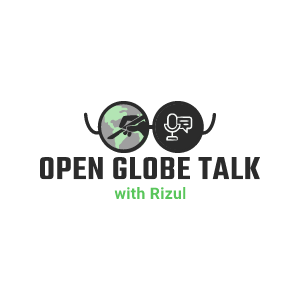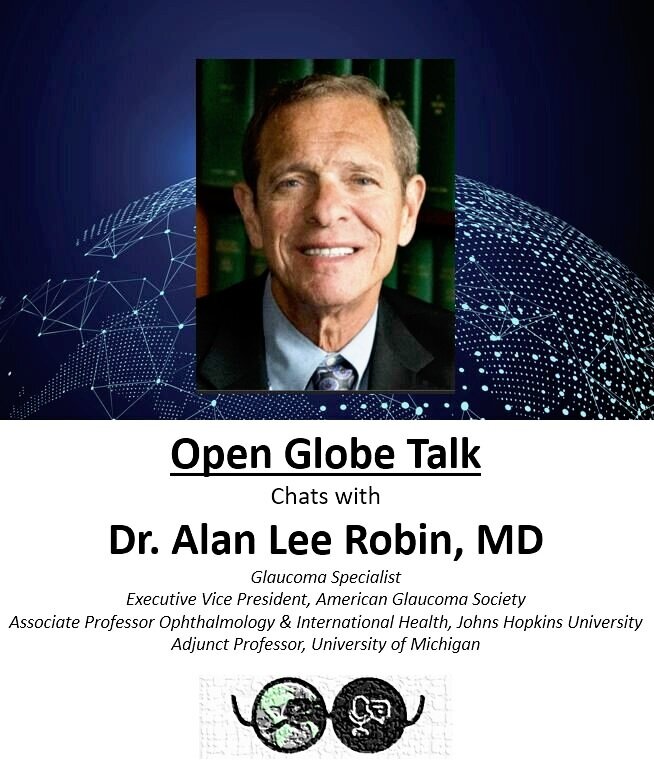October 1st, 2021
Episode 12: Dr. Alan L. Robin, MD
A discussion on
“Practicing the Art of Global Ophthalmology to Cure Needless Blindness & The Aravind Eye Care System”
An inspirational journey filled with mentors and colleagues dedicated to the field of Global Ophthalmology
Dr. Alan L. Robin, MD
In this episode of Open Globe Talk, we feature Dr. Alan L. Robin, MD, a leader in global ophthalmology and glaucoma. Dr. Robin currently serves as the Executive Vice President of the American Glaucoma Society. He also holds joint Associate Professorships in Ophthalmology and in International Health at the Johns Hopkins University and is an adjunct Professor at the University of Michigan. Dr. Robin attended his undergraduate at Yale College and obtained his medical education from Tufts University School of Medicine. Thereafter, he completed his residency in Ophthalmology from The Greater Baltimore Medical Center and received his glaucoma fellowship training at the Johns Hopkins Medicine Wilmer Eye Institute.
Dr. Robin is a member of 2 prestigious and highly selective organizations: the American Ophthalmological Society and the Glaucoma Research Society. Among the many awards he has received, he has been recognized with the Outstanding Humanitarian Service award by the AAO, and the Humanitarian award by the American Glaucoma Society.
Today, we are excited to discuss his journey in global ophthalmology and his glaucoma work at the Aravind Eye Care System!
Key discussion points:
How did Dr. Robin get interested in Ophthalmology?
His link with Art History
How did Dr. Robin choose Glaucoma as his sub-specialty?
“Field where a great amount of service can be done”
Inspiration from ophthalmic missionary work of Dr. Norwell Christie
Social marketing, appreciating different cultures
Work with Dr. IP Pollack & Dr. Harry Quigley
Work in Laser research to cure Angle-Closure Glaucoma disease.
Prevalence study in Northern Alaska for Angle-Closure Glaucoma disease
Managing and financing global ophthalmology work
Initial trips abroad were longer
Importance of family support
Aravind’s ophthalmic technicians that are trained to serve multiple roles
“Sisters” = young high school female students who are empowered by work to afford their dreams and future while preparing them for the social and professional worlds.
Allowed the development of ‘Vision Centers’ with synchronous telemedicine. Located more than 45 minutes from a major hospital.
The Aravind Eye Care System
In what ways can we incorporate this system in the United States?
Innovating
“If someone is knocking on the door, open the door, see who it is and if it’s something good, try to take advantage of it!”
Have a good sense for things that you don’t know and things that you DO know.
How did Dr. Robin help start the glaucoma department with Dr. Krishnadas and Dr. Ramakrishnan at Aravind?
First publication proving ability to do extra capsular cataract surgery with intraocular lenses in the developing world
During this period in Nepal, Dr. Robin met Dr. Govindappa Venkataswamy, founder of Aravind Eye Hospital
Importance of developing warm and close relations with the people you work with abroad
Infrastructure in India was very good even at the early times of Aravind
Advantages of the Indian Healthcare System
Green Ophthalmology
Carbon footprint in Aravind is much less compared to the US
Ravilla D. Thulasiraj, MBA
Looking at every process from a business perspective to decrease waste
Biodegradable bag for holding intraocular lenses and much more
How does Aravind address Glaucoma?
Cataracts have good social marketing compared to glaucoma
Glaucoma treatment that may or may not work can be expensive.
Aravind created a similar device for treating glaucoma with the help of Dr. George Baerveldt
Costs around $50 USD
A real service to developing countries
Starting the Prevalence Study in Aravind
Included cataracts, trauma, uveitis, retinal diseases, pseudoexfoliation, glaucoma and much more!
Please check out the Resources page (link below! or click on Resources tab above)
Low-cost budget
Ongoing work to become center of excellence for promoting research in under-developed countries
Global Ophthalmology Training and guiding ones career successfully
“Be Community-savvy and Community-oriented”
Considerations for pursuing MPH?
Ask yourself “Where do you get the biggest bang for the buck where you help the most number of people and harm the least?”
“Always have a Niche!”
Make sure you do a fellowship so that someone knows you have a talent to share. Also best part of global ophthalmology is you develop new talents!
Episode-based Resources:
This episode’s resources are key and a must for anyone considering Global Ophthalmology. Please check them out through the link below.


